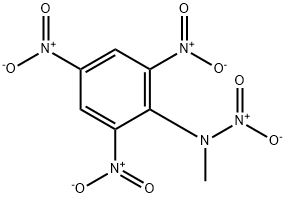479-45-8

Product Name:
TETRYL
Formula:
C7H5N5O8
Synonyms:
Methyl-2,4,6-trinitrophenylnitramine
Inquiry
CHEMICAL AND PHYSICAL PROPERTIES
| Physical Description | Tetryl appears as a yellow crystalline solid high explosive. Toxic by ingestion and skin absorption. A skin irritant. Will explode if heated above 370 °F. Used as a detonating explosive. The primary hazard is the blast of an instantaneous explosion and not flying projectiles and fragments. |
|---|---|
| Color/Form | Colorless to yellow, crystalline solid |
| Odor | Odorless. |
| Taste | BITTER TASTE |
| Boiling Point | 356 to 374 °F at 760 mmHg (Explodes) (NIOSH, 2023) |
| Melting Point | 268 °F (NIOSH, 2023) |
| Flash Point | Explodes (NIOSH, 2023) |
| Solubility | 0.02 % (NIOSH, 2023) |
| Density | 1.57 (NIOSH, 2023) - Denser than water; will sink |
| Vapor Pressure | less than 1 mmHg (NIOSH, 2023) |
| LogP | log Kow = 1.64 /Estimated/ |
| Henry's Law Constant | Henry's Law constant = 2.7X10-9 atm-cu m/mol @ 25 °C /Estimated/ |
| Stability/Shelf Life | Is highly stable losing virtually no weight on prolonged storage at 80 °C. |
| Decomposition | When heated to decomposition it emits toxic fumes of /nitrogen oxide/. |
| Heat of Combustion | 842.3 kcal @ 20 °C |
| Kovats Retention Index | 2100 |
| Other Experimental Properties | Hydroxyl radical reaction rate constant = 1.3X10-12 cu cm/molecule-sec @ 25 °C /Estimated/ |
| Chemical Classes | Other Uses -> Explosives |
SAFETY INFORMATION
| Signal word | Danger |
|---|---|
| Pictogram(s) |
 Flame Flammables GHS02  Exclamation Mark Irritant GHS07 |
| GHS Hazard Statements |
H225:Flammable liquids H319:Serious eye damage/eye irritation |
| Precautionary Statement Codes |
P210:Keep away from heat/sparks/open flames/hot surfaces. — No smoking. P261:Avoid breathing dust/fume/gas/mist/vapours/spray. P337+P313:IF eye irritation persists: Get medical advice/attention. P403+P235:Store in a well-ventilated place. Keep cool. |
COMPUTED DESCRIPTORS
| Molecular Weight | 287.14 g/mol |
|---|---|
| XLogP3 | 1.7 |
| Hydrogen Bond Donor Count | 0 |
| Hydrogen Bond Acceptor Count | 9 |
| Rotatable Bond Count | 1 |
| Exact Mass | 287.01381213 g/mol |
| Monoisotopic Mass | 287.01381213 g/mol |
| Topological Polar Surface Area | 187 Ų |
| Heavy Atom Count | 20 |
| Formal Charge | 0 |
| Complexity | 409 |
| Isotope Atom Count | 0 |
| Defined Atom Stereocenter Count | 0 |
| Undefined Atom Stereocenter Count | 0 |
| Defined Bond Stereocenter Count | 0 |
| Undefined Bond Stereocenter Count | 0 |
| Covalently-Bonded Unit Count | 1 |
| Compound Is Canonicalized | Yes |
PRODUCT INTRODUCTION
description
The chemical name for tetryl is 2,4,6-trinitrophenyl-n-methylnitramine. Some commonly used names are nitramine, tetralite, and tetril. Tetryl is an odorless, synthetic, yellow crystal-like solid that is not found naturally in the environment. Under certain conditions, tetryl can exist as dust in air. It dissolves slightly in water and in other liquids. Tetryl was used to make explosives, mostly during World Wars I and II. It is no longer manufactured or used in the United States. Stocks of tetryl are found in storage at military installations and are being destroyed by the Department of Defense (DOD).